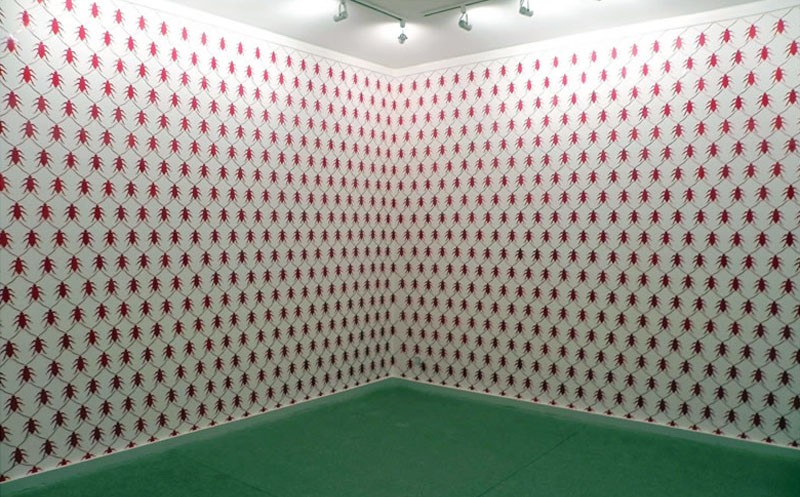
Cockroaches continue to crowd Tazeen Qayyum’s paintings and installation with varying interpretations at Canvas Gallery Karachi

More than a decade ago, an international bank started its publicity campaign, recognising the differences between societies and cultures. In one out of a series, a set of three posters had an identical image of a cockroach with three different captions: ‘Pest in America’, ‘Pet in China’, ‘Appetiser in Thailand’.
In a way, Tazeen Qayyum is trying to communicate the same content through her art. In her work cockroach, which crowds all her paintings and installation, serves to denote meanings which are not usually associated with the insect. As an artist living away from her homeland, all that is associated with a cockroach can be extended to explain different situations -- for instance, the overt and hidden practices of discrimination and racism.
The discrimination is not just directed at other human beings (due to their colour of skin, dress, set of beliefs, language), it is also about how animals are perceived by mankind. Thus certain creatures are ridiculed, despised and destroyed merely because they are considered unclean, harmful or ugly. Others are appreciated and loved to the extent of turning them into pets, and treated like family members.
Our behaviour towards animal kingdom needs to be analysed because it says more about us than the animals we refer to. In a sense, Tazeen Qayyum addresses this tendency in her solo exhibition ‘(IN) Surge (NT)’ at the Canvas Gallery, Karachi. Curated by Zarminee Shah (and held from April 21-30, 2015), the exhibition included installations and works on paper. The link between these two genres was the emphasis on cockroach since it crouched in a circle on the ground, occupied the surfaces of her miniatures, emerged out of drain pipes and covered the walls of a room in the gallery space.
In the words of curator and artist Zarminee Shah, "Tazeen Qayyum continues her investigation of the complex and shifting nature of political landscapes, particularly in the context of the fear of the ‘other’ following the war on terror and its direct ramifications on the lives of ordinary people. The metaphor of the cockroach entered Qayyum’s work in 2002, addressing issues of human rights violation."
Historically, the insect is identified as a specie that can not be controlled, subjugated, overcome or wiped out. In a sense, these cockroaches can be compared to the Muslim population that never mingles with the mainstream, may not be destroyed, and survives in the most hostile circumstances. Interestingly, the cockroach is locally known as laal baig a name that makes those who trace their lineage from the Mughals a little uncomfortable but actually must have been a vernacular deviation on laal (red) bug.
On a conscious level, Qayyum replaces or represents the red bug for the Muslim population residing in the Western world. Like a person who comes across the cockroach in the house and does not know how to tackle it, the West is still not clear how to deal with this community.
Qayyum’s work takes its source from the Muslim migrants and their unwillingness to adjust into a larger narrative. The individual’s fear of not knowing how to treat a bug like cockroach is translated and transformed in a society’s panic on how to resolve the issue of immigrants. It can be easily spotted in her exhibition where cockroaches are coming out of three drainpipes or clustered in a group on the floor or stuck like a pattern on the four walls of a room in the gallery.
Not only in her installations but in her works on paper too, these cockroaches are extensively portrayed to the extent that one does not see any other visual/images except these bugs composed in a pattern. One explanation for this could be the customary practice among artists (especially those trained in miniature painting) to pick an animal as a recurring visual in their works. In some cases, this selection is short-lived, while for others it continues for longer periods and becomes their identity mark.
It appears that, for Tazeen Qayyum, the preference for cockroach owes itself to its supposed connection with the Muslim minority in the European world -- a community that is often despised and occasionally deported.
However, the use of this symbol both in her installations and works on paper has a peculiar quality. Laser-cut acrylic cockroaches were arranged like a wall paper in one room, while clusters of the same material appeared to be erupting out of drainpipes. Surfaces of these pipes were drilled to make holes of various dimensions; thus the items had more of a decorative quality. In a similar sense, the arrangement of acrylic cockroaches on the floor, wall or their shapes/outlines on papers reflected the artist’s preference for pattern-making.
Using a symbol of social-political situation into a decorative setup has a connection with the normal practice of transforming serious issues into trivial matters.
The cut-outs of cockroach or its drawn and painted versions fail to arouse any feeling of nasty presence or negative association. Yet, this modification may be read as the artist’s act of conveying her position vis-à-vis civilisational conflicts. Turning cockroach into a pattern is not an attempt of taming it but may have been an effort to draw on the tradition of geometric patterns and its association with Muslim art and aesthetics.
This connection is understood as one realises that the insect -- not quite unlike the immigrants -- survives in the most difficult and hard circumstances.